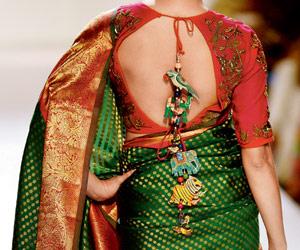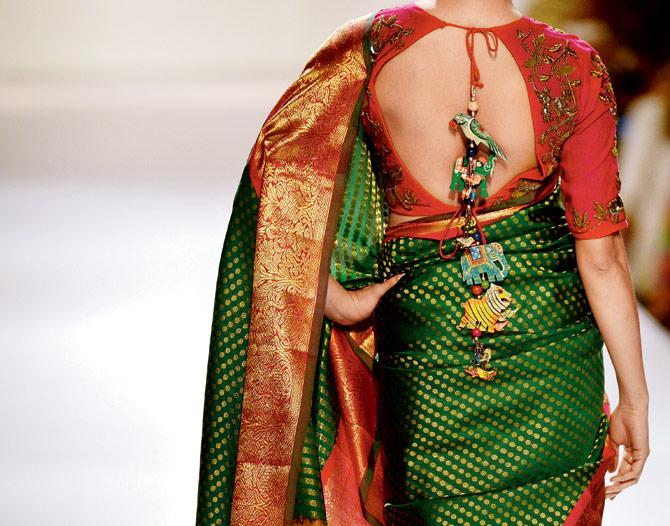Mumbai's fashion community riled by ill-informed New York Times article linking the drape's revival to Modi and BJP's rise

The saree refuses to leave the spotlight. After hitting the headlines because its handloom avatar has enticed both the celebrity and the millennial, it is now at the center of a controversy. A report published in the New York Times, titled, In India, Fashion Has Become a Nationalist Cause, has stirred the hornet's nest because it spoke of the Banarasi saree in the same breath as Prime Minister Narendra Modi's Hindutva agenda. Journalist Barkha Dutt called it "stupid" on Twitter, and crafts activist Laila Tyabji alleged that the article's writer Asgar Qadri conveniently omitted her comment after he realized it wasn't going with his theory. Qadri wrote that Modi's plan to infuse Indian-ness in Indian fashion was executed by the likes of BJP spokesperson and fashion designer Shaina NC, who launched the Banarasi Textiles Revival Movement in 2015 to promote a weave that is "primarily worn by Hindu women".
ADVERTISEMENT

A report published in the New York Times spoke of the Banarasi saree in the same breath as Prime Minister Narendra Modi's Hindutva agenda. Pic/Getty Images
'Irresponsible, ill-informed'
Shaina rubbishes the claim, saying, "We had noticed that weavers in Varanasi were switching jobs to work in factories and as security guards. With this programme, we wished to provide them sustainable employment. The piece is not only irresponsible, it is ill-informed." Industry insiders in fact say Qadri's article is ironical, considering those dealing in the Banarasi sarees were dealt a blow by the government when it levied a five per cent GST on textiles that were until then exempt from the taxation curve.

Radhi Parekh, Crafts Promoter
Long before Modi
Anavila Misra, who is known for her light-as-air linen sarees, thinks the article contradicts the effort that designers like her are making for the saree to gather international appeal. "Its resurgence began long before Modi came to power. Nobody can force you to wear the saree, certainly not Modi." Misra works with weaver clusters in West Bengal, and says that the article's portrayal of the weaver or bunker as exploited, is erroneous. "Today, weavers are well-linked with urban markets. With easy access to the Internet, when it comes to online shopping, it's not easy for designers to mask the prices their garments can command," Misra argues.

Anavila Misra, Designer championing the linen saree
Ethnicity, not nationality
Radhi Parekh, founder of ARTISANS', the Kala Ghoda-based gallery committed to supporting India's indigenous art, craft and design heritage, works with weavers from Kutch and Bhujodi. "I can safely say that 70 per cent of profits from sales goes back to the artisans. Until a few years ago, the weavers considered themselves labourers, but the income has renewed their confidence. I wear a saree to express my ethnicity, not my nationality. And that distinction is important," she says.
Meanwhile, Malika Verma Kashyap says that the saree has always been a part of political conversation. "A former prime minister [Indira Gandhi] wore it and made it famous. Speaking about it in the same breath as politics gives it power," says the founder of Border & Fall, a multi-disciplinary agency. It launched The Sari Series: An Anthology of Drapes last month, documenting the various regional saree drapes through 80 how-to-drape short films and three independent art films. Kashyap and her team spent months working on the mammoth project that quite simply aspires to make saree-wearing approachable and fun. "Talking of the government, while Union Minister of Textiles Smriti Irani appreciated our effort, she did not offer us funding."
Kashyap says it wasn't until she read the article that she learnt that the saree could be viewed as "Hindu attire". "Drapes may differ, but everyone in India wears the saree, from the Parsis of Bombay to Christians in Goa. It has a region-centric identity, not religious."
Also see: These Mumbai tantriks raped women on the pretext of 'healing' them
 Subscribe today by clicking the link and stay updated with the latest news!" Click here!
Subscribe today by clicking the link and stay updated with the latest news!" Click here!







